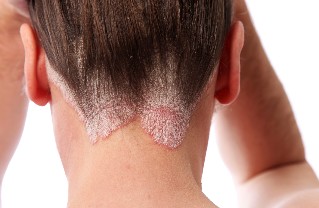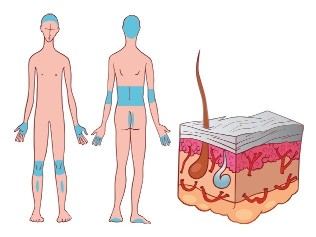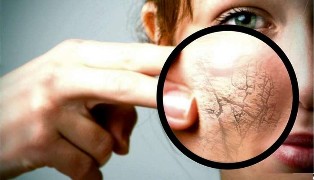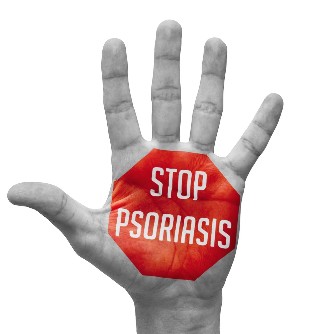
What is psoriasis
Psoriasis (psoriasis) – non-communicable chronic skin disease, which manifests itself in the form of peeling and rashes on the skin. Characterized by a wavy the procedure, with periods of remission (improvements) and periods of exacerbations. The disease can develop at any age, but most often psoriasis affects people at a young age.
The intensity of psoriasis can vary greatly in different stages. The disease can affect only a smaller part of the skin cover or cover the whole body. Often the disease progresses, patients note that over time (in the next period of exacerbation) psoriasis affects large areas of the skin. In addition to the skin also secrete psoriasis of the nails, which may be in isolated form.
Psoriasis – the causes of the disease
The cause of psoriasis is not known, but to provoke the disease can immunological changes in the body (autoimmune aggression), neurological disorders, metabolic disorders. Support the formation of psoriasis heredity, decreased immunity after illness, stress.
To date, between reasons and factors in the development of psoriasis issued the following:
- Hereditary predisposition (genetic theory of development of psoriasis). The likelihood of developing psoriasis is higher, if the person's nearest relatives also suffer from this disease. Maybe that some groups of genes are responsible for the implementation of the psoriasis.
- Neuro-psychic overvoltage (neurogenic theory of the development of psoriasis). It is known that psoriasis can be caused by severe emotional turmoil. Stress belongs to the major factors of development of this disease. In people with psoriasis, stress can cause exacerbation of the disease.
- Hormonal disorders. Changes in the work of glands with internal secretion may be a trigger mechanism in the development of psoriasis.
- A violation of the metabolism (exchange of theory, development of psoriasis). Problems with the exchange of substances, some vitamins and trace elements (especially silicon), is it possible, contribute to the formation of psoriatic plaques.
- Parasites. It is considered the parasitic theory of the development of psoriasis, according to which the disease is caused by certain disorders of the intestinal parasites. Numerous studies show that in people who suffer from psoriasis, many carriers of different parasitic infections. As scientists believe, a special role in the development of the disease can play a roundworm, giardia, bullish tapeworm and more. It is believed that the toxic products that they emit, these parasites are strong allergens, and becomes the cause of the imbalance in the functioning of the immune system.
- The viral infection.
And although the reasons for the development of psoriasis is not up to the end clear, to date, the drug is known the mechanism of occurrence of this pathology. On the basis of the appearance of psoriatic acne lies contrary to the work of the immune system. The immune cells become aggressive towards its own cells of the skin, which leads to the formation of psoriatic plaques.
Psoriasis – symptoms
Psoriasis is manifested by the emergence of the peeling patches, plaques of red color that are severely itchy. The spots are most commonly found on the skin of hair part of head, elbow joints, knees, in skin folds. Time superficial flakes easily removed, in their place, to remain more dense flakes, deep. In the progression of psoriasis has occurred the so-called phenomenon of Kebnera: the emergence of psoriatic commemorative plaques in places, scratches or injuries of the skin.
Here are the signs characteristic for different types of psoriasis:
- Psoriasis in the form of plaques looks like raised above the surface of healthy skin lands are red, inflamed, dry, thickened, hot to the touch, the skin, covered with silvery white scales (psoriasis food stamps). The skin on these places is prone to peeling. In place of the skin, which is peeled off, remain red pockets, which are easily injured and bleed. Psoriatic food stamps usually coincide between each other, growing in size and forming plates plaques ("paraffin lake"). With psoriasis flexion surfaces peeling expressed weakly. When it arise red spots, which are found in the skin folds (groin, the area of the external genitalia, inner thighs, belly folds, underarms).
- Teardrop psoriasis is characterized by large amounts of dry, small, red or purple lesions, raised above the surface of the skin, in the form reminiscent of drops of tears, or bubbles. These elements affect large areas of skin. Teardrop psoriasis often develops after a history of strep infection (e.g., pharyngitis or tonsillitis).
- Pustular psoriasis looks like raised above the surface modifications on the skin of pustules, which are filled with transparent content. Pustules are surrounded by a red edematous skin that is easy to peel off. Nail psoriasis is characterized by changing the color of the nail, the nail bed, the advent of points, spots, transverse striations on the nails, thickening of the skin around the nail bed, thickening, and a bundle of nails, complete loss of nails.
- Psoriatic arthritis is accompanied by inflammatory processes in the joints and connective tissue. Psoriatic arthritis most often affects the small joints of distal phalanges of the fingers on the hands, on the feet, causing psoriatic dactylitis. Psoriatic erythroderma is manifested by frequent peeling and inflammation, department of skin on large areas of the body, swelling, soreness of the skin, intense skin itching.
Other symptoms of psoriasis include:
- bleeding area on the skin;
- the formation of scratches and dimples on the nails;
- severe itching;
- possible joint pain and swelling.

Classification of psoriasis
We distinguish the following types of psoriasis:
- vulgar (or common) of psoriasis;
- exudative psoriasis;
- arthropathic psoriasis;
- psoriatic erythroderma;
- psoriasis of the palms and soles of the feet;
- pustular psoriasis.
Psoriasis takes place in three stages:
- Progressive stage of psoriasis. This is the first stage of the disease, characterized by deterioration, which is celebrated to increase the amount of fresh rashes.
- The stationary phase of psoriasis. The current period is characterized by the safety of the existing picture of the disease. Rashes and other symptoms of psoriasis still is neither more nor less.
- Stage of psoriasis which subsides. This is the final stage of the disease, in which rashes are missing.
Depending on the prevalence of disorders of the process of psoriasis becomes:
- restricted – affects a small part of the body;
- common – affects a significant part of the body;
- generalized – attacks almost the entire body.
Depending on the time of year when the disease worsens, psoriasis becomes:
- winter – exacerbation of psoriasis, usually occurs in the cold season;
- years ago – worsening of psoriasis occurs in the summer period;
- uncertain – when the period of exacerbation of psoriasis are not associated with a certain season of the year.
Diagnosis of psoriasis
To diagnose the disease, the doctor-dermatologist on the basis of typical clinical pictures. To refine the diagnosis for applying a biopsy of the skin.
The action of the patient
You can take a sun bath for 15 minutes a day. It is necessary to refrain from drinking alcohol as possible, avoid stress, watch your weight, lead a healthy lifestyle, to properly care for the skin.

Treatment of psoriasis
For the therapy of psoriasis apply emollients, medications, which restores the stratum corneum, topical preparations (ointments, lotions, creams) containing a glucocorticoid (hydrocortisone, prednisone, dexamethasone), preparations containing pyrithione zinc, ointments containing analogues of vitamin D3, tar, Naftalan, hydroxyestrone. In the more severe forms of psoriasis, the inefficiency of external beam therapy, the loss of more than 20% of the surface of the skin prescribe systemic medical therapy, which includes cytotoxic drugs (methotrexate), synthetic retinoids (retinol or acetate, retinol or palmitate, tretinoin), glucocorticoids, multivitamin (aevitum, etc.).
A special role in the treatment of psoriasis must be allocated to some biologically active substances, among which it is worth noting that:
- Silicon. In recent years, doctors increasingly talking about the role of silicon in the development of psoriasis. One of the components of treatments for psoriasis are medications and vitamin-mineral complexes, which contain silicon. On the one hand, silicon improves the condition of skin, and the other – acting in the role of a sorbent, which is sucked to the self antigens that play a role in the development of psoriasis.
- Vitamin D. it is known that one of the most important minerals that are needed for a successful battle with psoriasis, is a calcium. However, for the normal absorption of calcium is needed vitamin D. The best products with vitamin D belongs after transmission of the active phase of psoriasis fixed.
- Fish oil and omega-3 acids. For the removal of the inflammatory process with psoriasis is to be written into the body of the polyunsaturated omega-3 fatty acids, which in large quantities contained in fish oil.
- Lecithin. This substance is necessary for the rapid recovery of epithelial cells, which die with psoriasis. Products with lecithin will allow you to quickly deal with the inflammatory process and restore the integrity of the skin sheets.
Non-drug therapy lies in the systemic photochemotherapy: exposure to ultraviolet light of wavelength 320-400 NM on the background of the intake of photosensitizers (PUVA-therapy). Also use cryotherapy, plasmapheresis.
The patient should follow a special diet. Diet with psoriasis should be balanced. The patient should be removed from the diet of refined foods, spicy foods and sweets. It is necessary to carefully monitor their health and every possible way to avoid colds disease, because any violation of the immunity may induce the development of the disease.
Complications
Among the possible complications arthritis, depression caused by low self-esteem.

Prevention of psoriasis
To prevent the disease, it is impossible, but there are methods that allow you to alleviate the manifestations of psoriasis and reduce the number of exacerbations. It is necessary to protect skin from overdrying, avoid prolonged sun exposure, to try to prevent injury to the skin. It is necessary to avoid stressful situations, infections, intake of drugs that manifestations of psoriasis (e.g., beta-blockers, lithium), stop smoking, reduce drinking alcohol. And remember that treatment of psoriasis is a need to entrust the work to professionals. Treatment of psoriasis in the household and all kinds of self-treatment of this disease is unacceptable.























